|
|
 Last month, I’ve been mostly reading Thinking Beyond Lean by Michael Cusumano and Kentaro Nobeoka. Last month, I’ve been mostly reading Thinking Beyond Lean by Michael Cusumano and Kentaro Nobeoka.
The book describes the move from single- to multi-project product development at the major automakers and the different strategies they use.
Typically, Toyota was the first company to move in this direction. At a time when other car makers were starting to adopt Toyota’s “Lean” product development model, Toyota started to think that their product development model should be improved.
Lean product development
What are some of the characteristics of “Lean” product development?
- Development is led by a “heavyweight project manager”, someone with a lot of authority, well-respected because of his technical experience and who has a clear vision of the product to built.
- Development teams are cross-functional and co-located: designers, engineers, production engineers all work together from the start and work is integrated frequently. At the end of the development process, the product is well-integrated and ready to be produced efficiently.
- People stay on a team beyond a single project, to preserve the implicit knowledge, processes and working habits.
Agilists will recognize many traits of this model. The “heavyweight” project manager is odd: imagine someone who’s the onsite customer, the coach, the manager and the technical lead all rolled into one. It’s astonishing that Toyota is able to grow such supermen.
But, Toyota started to see some drawbacks…
- because the teams wanted to make ‘their’ car the best they could possibly build, lower-end models started to get high-end features. This not only made the cars more expensive, but the distinction between models started to blur. Some of the models became competitors and “cannibalized” each other’s market.
- to reduce costs, car makers increasingly (re)use common parts. The major shift is towards common “platforms”, the base of the car. However, it was hard to coordinate the different independent projects to reuse parts and to transfer knowledge from one project to another.
- team members became more generalists, less specialists. This is great for working as a team, but there were fears that the engineers would lose their technical “edge” and would no longer be innovative.
These drawbacks are not unique to car makers. Similar problems are encountered by teams working “vertically”: each team builds one application from start to finish. The resulting systems are “silos”, completely independent applications with nothing in common.
What to do then? Move back to a “horizontal” organization where people are organized by what they do, not what they work on? Create a design group, a chassis group, an engine group…? That’s great for innovation in each area and reuse. But it’s hellishly hard to coordinate all those departments to build something that has conceptual integrity. There’s a real danger that each department will optimize their own work, at the expense of the overall result.
I’ve seen many organizations flip-flop between the two models, never satisfied with the results.
Beyond Lean
Toyota didn’t go back to the old model. They went the “Development Center” way:
- There are 4 development centers
- 3 development centers each develop several models. The different models in a development center typically share a small number of platforms.
- the fourth development center is responsible for research and parts that are common to all models
- Each development center is run by an experienced ex-heavyweight project manager, whose job is to coordinate the effort of the product project managers in the centre. There’s now a hierarchy of ‘chief engineers’, so that each of them only has to coordinate with a limited number of other chief engineers.
- Each development center has a simplified matrix structure:
- there a small number of functional groups (e.g. chassis engineering, power-train engineering…)
- product development is still done by heavyweight project managers, using a team composed of people from the different functional groups.
- For each component in a car, the appropriate level of reuse is determined:
- Is this something that is unique to one model, something that distinguishes this model from the others? Give the model’s project manager authority.
- Is this something that is common to the models in the development center, like the shared “platform”? Give the the development center’s manager authority.
- Is this something that is common to everything that Toyota makes? Is this something that requires a large R&D effort (like developing a hybrid engine)? Give the authority to “Development center 4”.
- For common parts, there is a limited choice (maybe 3-5 options), from which each team can freely choose. A new option is only added if it’s clearly superior to existing options; one of the existing options is dropped, to keep the number of choices down.
This system reduces complexity while promoting reuse within an appropriate scope. They’re still able to develop products quickly but also to reduce costs by reuse. And as Toyota grows, this structure keeps the number of communication lines and people to manage within manageable bounds.
What about agile software development?
That’s great for cars, what can we learn from this? Already, some people in the agile world are looking beyond single projects, because the same advantages and disadvantages as in Lean Product development are starting to appear. What can we reuse?
- Group several small agile teams in one unit, managed by an experienced agile team leader, who can coordinate the teams and see opportunities for cooperation.
- Reuse at the right level. Take into consideration the cost of reuse; the wider the scope of reuse, the larger the cost.
- If you use standard components, provide a small list of options. Too many choices means you won’t benefit from reuse; too few choices and chances are that none is a good fit to the problem.
Oh, and if you need to plan and coordinate multiple projects and their dependencies, look up “Critical Chain“.
A potential new bottleneck
Last week we noticed that some of our users didn’t know some features were available or were unsure how to use the new features in the previous release. So, we spent some time explaining some of the features.
This is a timely warning: our ability to effectively transition the software into production use could become a bottleneck. This is both a good and a bad thing:
- It means that our bottleneck, the development team, has been elevated to a level that’s nearer the capacity of the users to accept new features. This is good: our efforts to elevate the constraint are starting to work.
- Our capacity to train users and the user’s capacity to accept new features might become the new bottleneck. This is bad news: we don’t want the bottleneck to get out of our control.
This is a typical pattern for agile processes: the development team is elevated and after a while the customer, who subordinates to the development team (as the XP customer does), becomes the bottleneck. Suddenly, the customer can’t write stories fast enough to keep the team occupied; releases are implemented so quickly that the users can’t keep up with the flood of new features.
What to do?
Before the users become the new bottleneck, we need to take measures to elevate them so that the bottleneck doesn’t shift. What are we going to do?
- We have regular meetings with our key users who follow up new developments. We need to make these more “hands on”: show the users how new features work, let them experiment some more.
- Training and transition to a new release is handled by people in the users’ organisation. We can support them more during final acceptance testing and transition to the new release.
- We can hold an “end of sprint demo”, like Scrum prescribes to show the new features (and how they’re to be used) to a wider audience than the key users.
- Each release is focused on one group of users. For example, the current release contains mostly features for the commercial people. They will need some training to use the new release. Other groups will see only a few minor changes, so that for them the application doesn’t change too much.
Release less often?
Some have suggested that the problem is caused by us releasing too often. We release every two months. Should we release less often? I don’t think so: we used to release every 6 months and that caused big acceptance, transition and training problems. In comparison, today’s problems are insignificant.
I would suggest to release more often, establish a regular rhythm of changes. Have each release contain fewer changes, changes that appear shortly after the users ask for them and they’re fresh in their mind. Get a regular rhythm going on the “drum“, increase the “takt time”, level the load to reduce the waste due to unevenness.
Making change routine
People don’t like to change. They like routine and predictability. How can we make change easier? Regular “Kaizen” events, regular retrospectives to steer the process establish a rhythm of change. If you review and improve your process each month, every month, people become accustomed to the change.
If you want to change the routine, make change routine
The project burn up/down chart
Our team has a very public burn up/down chart. This is where we stand today.
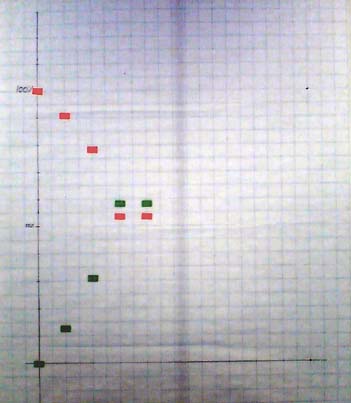 A short reminder: A short reminder:
- The red line tracks the burndown of estimated story work to do
- The green line tracks the delivery of estimated story value
What happened in the past two weeks?
Two weeks ago, both graphs went sharply up/down. The value chart a bit steeper than the cost chart, because we work on the highest value stories in the beginning of the project
Last week the chart was flat. No story completed this week. Oooops….
Why?
- One story counted two weeks ago turned out to be incomplete. Added some more tests to make the problem apparent, completed the implementation. No extra points, as they were already counted. If we hadn’t completed the story before the end of the week, we would have subtracted the effort and value.
- We’re all working on big, 4-5 point stories. When these complete we’ll have another big jump on the chart. That’s another disadvantage of big stories, they don’t help us level the load and they make tracking less smooth. Maybe we’re in trouble, but we won’t see quickly. We’ll only know next week, when these stories are expected to finish.
- Some of our users seem to be unclear on what new features are available and how to use them, so we spent some time explaining how the application works.
Lessons learned:
- Spend more time on tests, especially acceptance tests
- How could we have broken down these stories in 2-3 point parts?
- User acceptance of new features could become a bottleneck. Read more….
Big VISIBLE chart
People passing by and looking at the chart came up to me and asked “Hey, what’s wrong? Your graph is flat.“. Now that is instant visibility into the state of the project. Passers-by know at a glance when we’re doing well or badly.
Not bad for a tool that cost almost nothing and takes 10 minutes a week to update…
If you believe the Theory of Constraints, you know a few things:
- the throughput of your system is determined by the throughput of your bottleneck
- you should keep the bottleneck working at 100%
- you should keep the non-bottlenecks working at less than 100%, so that they don’t generate wasteful work-in-progress or are unable to cope with fluctuations.
How do the non-bottlenecks know how fast they should work, without having a global coordination? By using the “Drum-Buffer-Rope” technique.
The system
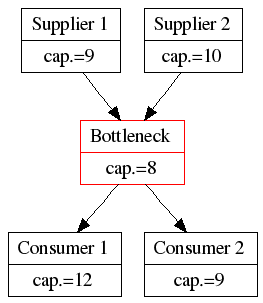
The Drum
The bottleneck determines the speed at which the system works. This bottleneck can produce 8 items per unit of time. Therefore the bottleneck acts as a drum, beating the rhythm that the whole system should follow, like a drummer on a galley slave or the drummer of a marching band. The system has a rhythm of 8, so all participants in the system should follow the rhythm. This is one way to Level out the load. In Lean Thinking, this is called the “Takt Time”.
So, now we have everybody working at 8 items per unit of time.
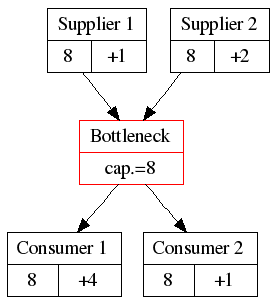
The Buffer
But what if supplier 1 or 2 can’t produce exactly 8 items? The bottleneck will be starved and we lose precious throughput. That can’t be allowed to happen. Therefore, put a buffer of raw material in front of the bottleneck, so that it never has to wait.
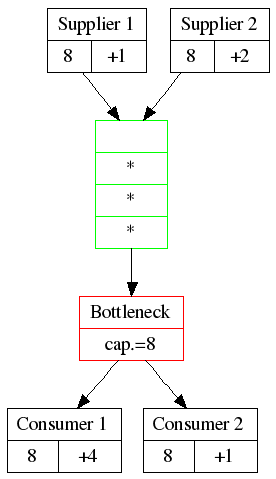
The Rope
Supplier 1 and 2 won’t always be perfectly in lockstep with the Bottleneck. We don’t want the buffer to become too big or too full, because then we have a lot of work-in-progress (and all the problems of cost, quality and overhead that generates). The bottleneck needs to limit the size of the buffer. Therfore, let the bottleneck signal to its suppliers when it has consumed an item and therefore should receive one item. Each time the bottleneck has consumed something, they ‘pull a cord’, which signals that a fresh item should be delivered. This is ‘Pull Scheduling‘
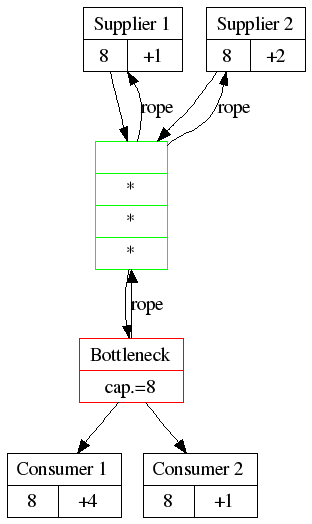
Spare capacity
We can see how suppliers and consumers need a bit of spare capacity:
- If the suppliers don’t have spare capacity, they will never be able to re-fill the buffer if something goes wrong
- If the consumers don’t have spare capacity, they won’t be able to handle fluctuations in output from the bottleneck and may thus delay processing bottleneck output.
Only Consumer 1 has a lot of spare capacity (+4). They might spend some of that capacity on other work, as long as they keep enough spare capacity to deal with the bottleneck’s output.
What does all that have to do with writing software?
Well, an IT project is a system that transforms ideas into running/useful software, where different resources perform some transformation steps. Each resource has a certain capacity and the steps are dependent on each other. And there’s certainly variation. Look quite a bit like the systems above.
Let’s see if we can apply Drum-Buffer-Rope to software development…
If we reward people based on how high their velocity is, we’re in fact rewarding people who work hard. Or who game the the system. Assuming we trust the developers to be honest with their estimates (and there are plenty of forces helping them stay honest), what’s wrong with rewarding people who work hard?
Well, working hard is not The Goal of our team. Our goal is to create value for the people who pay for our hard work. If we want to optimize our system, we should be very clear about our goal and keep it firmly in mind.
Fortunately, value is pretty easy to measure and track IF each story has a value estimate by the customer. Just like we can measure the effort we put into the release by counting the story points of accepted stories, we can count the business value points of the accepted stories. And that’s exactly what we track on the burn up/down chart. As this chart is displayed where everyone can see it, we’re always reminded of our goal. Our goal is to:
- Create the highest possible business value in each release…
- …for the lowest possible cost per release
Therefore, we should be rewarded on the amount of value we release. As long as it isn’t released and used, the software’s value is zero.
“Hey, that’s not fair! We’re being rewarded based on value estimates made by the customer? What if the customers don’t know the value? What if they’re wrong? What if they game the system to lower the value? What if…?” Well… you do trust your customer to do a good job, to be honest, to be competent and to make an honest mistake from time to time, don’t you? If not, stop reading this blog and do something about it!
Like story point estimates, business value estimates should be consistent. Developers are allowed and encouraged to ask for the reasoning behind the value estimate. This nicely balances with the way the customer asks for the reasoning behind the story points estimates of the developers. But it’s ultimately the customer’s reponsibility to get the value right.
Customers and developers work together to maximize story value, like they do to minimize story cost. Before and during the planning game they should look critically at all the stories. Can we do this in a simpler way? Is there a way to get more value out of this story or to get the value sooner?
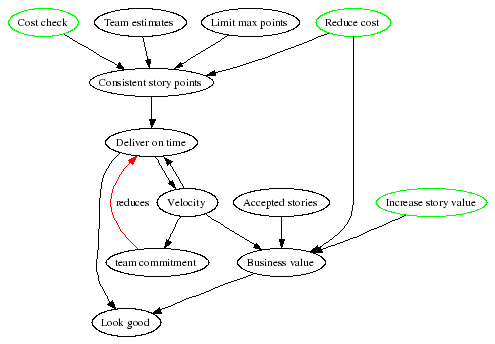
In this diagram we see that increasing velocity no longer makes you look good. Instead, producing more business value makes you look good. One of the ways to produce more business value is to genuinely increase the team’s velocity. Inflating story costs will not bring more value.
As in the previous diagram, if the team can deliver on time, their velocity will be a bit higher than planned. This means they will take on a little more work, commensurate with their increased velocity. But this reduces the odds that they will deliver on time next time, unless they find creative ways to increase their velocity.
We’ll see more about velocity in the next entry.
|
 Last month, I’ve been mostly reading Thinking Beyond Lean by Michael Cusumano and Kentaro Nobeoka.
Last month, I’ve been mostly reading Thinking Beyond Lean by Michael Cusumano and Kentaro Nobeoka. A short reminder:
A short reminder:



